How to Harvest a Marijuana Field
Learning how to harvest a marijuana field requires intense labor and sacrifice before it yields rewards.
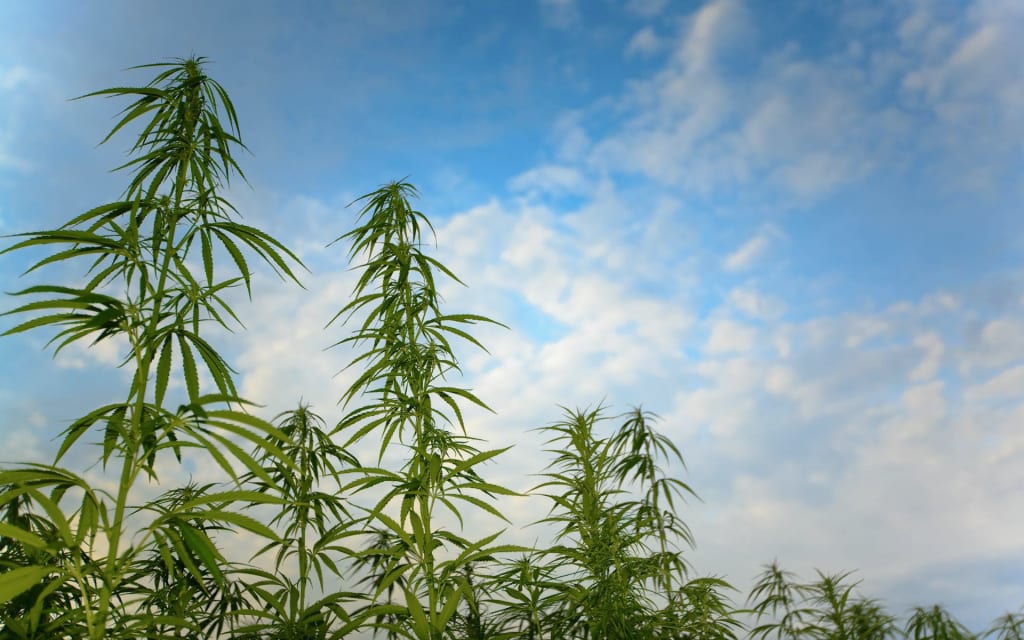
A group of enterprising young Americans packed up their belongings and moved to a secluded spot along a coast, where they spent the summer alternately lounging in the warm sun and learning how to harvest a marijuana field. They grew 1,000 plants, harvested the crop, and packed it into neat little tins. Everybody who bought it agreed it was good shit.
A short time later, one of the growers sat down before a journalist and recanted the whole story of this experiment in free enterprise. For obvious reasons—like going to jail—the interviewee has insisted on maintaining his anonymity. We'll simply call him "Charlie." Not only that, but the interviewer decided he didn't want to be identified either. We'll simply call him “Flash.”

Photo via NBC
Flash: Tell us the whole story.
Charlie: Well, listen, man, if we're gonna talk about the whole endeavor of learning to harvest a marijuana field, I guess I could start this thing about 22 months ago. Robert, Martin, and me went out and scrounged these old boards. Now you might wonder why we scrounged these old boards. Well, you know the shed in back of Robert's house? We closed up the whole back of the shed and we raised a crop of marijuana in there last year.
We did it with Grolux lamps. These are special lamps from Sylvania that are relatively cheap, but take a lot of current to run. The Grolux lamps are about 10' long, and we had to lower them down on pulleys. We had wires strung all over the shed. The shed was covered with black plastic and aluminum foil inside so no light would show through. And we had heaters going all the time to keep it hot. We grew 4 ½ pounds, though, in the winter.
But that's not what's important about it. What's important is that it was a working together combination of myself and Martin and Robert, who would go on to help me harvest a marijuana field.
Anyway, what we did is, we started the plants for this last trip in the shed. April 1, we started them in the shed under the lights after we got the other crop out. And then we went up to this place called Flydocker, which is about 1,500' up and it's... amazing. We brought all these plants—1,000 plants—to Flydocker in the back of a pickup truck.
The first day we got there, it poured rain. That was about the beginning of June or maybe a little before, in May. Only rained one day to make it miserable. All the clothes got wet, all the sleeping bags. We didn't have time to unpack. We just sort of got there and it was pouring rain. We couldn't sit in the truck anymore so we got out of the truck and climbed underneath and went to sleep. Stayed there for one day and one night, underneath the truck, all three of us.
How'd you find the place where you would harvest a marijuana field?
Well, Martin's friend owns it. It's a very expensive piece of property—what they call a “ranchero." It's 40 acres right on the ocean, on a southerly slope, with a big fir forest that looks like a meteor fell in the middle of it. There's fir, madrone, and oak growing in almost a perfect circle. Not quite perfect—we needed about 60 camouflage trees to fill in the holes.
In order to make a camouflage tree you had to dig a hole about 5' deep and 4' around, line it all completely with plastic, pack it with rocks, fill the plastic with water—which was a lot of water—and then cut a big fir tree about 8" around. Really heavy. Takes three men to move it. Cut it somewhere else, truck it over to where you're gonna put it up, put all these kinds of wires on it, and paint all the wires black so they can't be seen.
You mean you kept the trees alive?
No! We kept them like cut flowers! They would turn brown and we would pull them out and put new ones in their place. The last two months we had to do it three times. About 50 trees each time—150 altogether.
The work was gigantic. It was enormous. We got up every day at 5:00 AM. Sometimes Robert would come or Martin would come and set a cup of coffee on your chest. You just had to do something—right away—because of the hot coffee on your chest. It hurt. You had to pick it up. But it was OK because at least you had coffee.
We dug holes for two weeks. And then Robert and Martin went down and hauled all these plants up to Flydocker that we'd started in the shed. They were all about 2' 6". We had to haul them at night, you know, covered, so you couldn't see them in the truck. When we finally got them to Flydocker we put them outside and they just went poooom! They'd never been outside before.
So after we dug all these holes, we went down to a nearby bay and got eight gigantic loads of seaweed. And then we went to the local town and got 2,400 pounds of fertilizer—blood meal, crab meal, and bone meal. Then we took all this compost Martin had been saving for a year—two big pickup truck loads of that. Everything went into those holes we dug. Then the topsoil went back in.
Now our water system was very interesting. It was a 3 ½-mile drive to Curley Cow Creek. We would pump six 55-gallon drums at a time, and we would haul them four times a day. Twenty-four 55-gallon drums a day, we hauled. And we did that every day, including Sundays. And then we had to water all the plants in the marijuana field by hand. I forgot to tell you that—we had to water it all by hand, every day.
I lived all summer in this oak tree about five feet off the ground, on a platform I built. Up there they got huge oak trees. Tan oaks, big ones, with limbs that stretch straight out. I lived in this tree with this owl. It would come and visit me every morning and sit on my bed.
We ate lots of venison. We ate a bunny a day for a long time.
Did they eat the plants?
No, we had a fence around the whole marijuana field made out of woven chicken wire and barbed wire at the top. Woven in the trees, man. Nothing could get in. The only things we had trouble with were rats and grasshoppers. With the rats we didn't know what to do. We tried everything. We tried peanut butter in the traps. We caught rat after rat but they still ate the plants. They didn't really eat them, they just chewed on them and let them fall down. They wanted to sharpen their teeth on the big plants.
And then the grasshoppers. We tried every kind of thing you can imagine. We tried molasses and DDT. We finally killed the grasshoppers with chemical poison. We didn't spray it on the plants, only around the perimeter of the garden. Very thickly. And then we caught them.
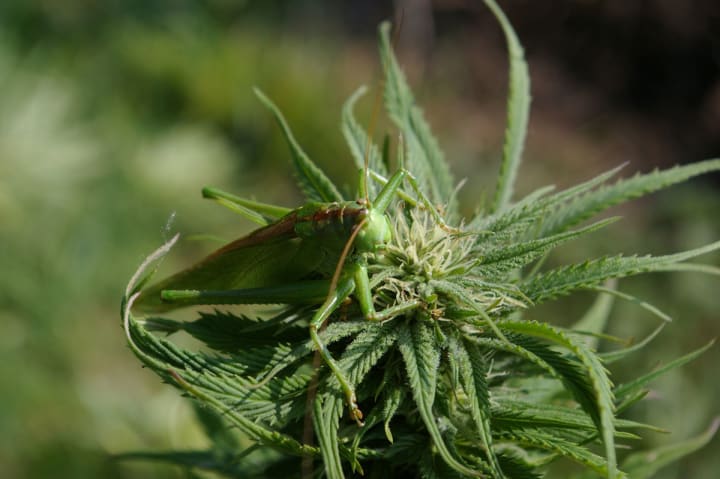
Photo via Sensi Seeds
Caught them? Caught the grasshoppers?
By the thousands. We spent days catching them. They were little tiny ones, half an inch long, smaller. Beautiful colors. Like their wings were every color of the rainbow. Brown ones in armor with black stripes. Little green ones with yellow horns on their heads. And blue ones.
Nothing kills grasshoppers. It's a problem throughout the world. The stuff we finally used was rootone and copper.
Let's see. We were talking about rabbits before we got sidetracked on rats and grasshoppers.
Well, our first rabbit was very exciting. A gigantic rabbit, bigger than any kind of bunny you find in someone's house. We cooked it for about five hours. Rabbit stew. It was big and tough, but it was delicious.
Before we killed our first rabbit we ate brown rice and canned food—canned apricots, canned peaches, pears, applesauce, canned Spam. We had about four months' stash of stuff. Lots of peanut butter, lots of cheese.
And we all had our little routines in the morning. We drank coffee. We ate vitamins.
It was so fucking hot, though, by that time. It was hot early in the morning until late, late at night. And the mosquitoes. They can smell a human being 400 miles away.
For the first six weeks we didn't go anywhere. We just worked on the marijuana field constantly. Then we ran out of gas and had to get some for the truck and for the water pump, which had a gas engine. We went out and got some fresh food. We got some meat. We got some milk. We got the newspaper.
Robert went into town and said he was going to get food stamps. He got this post office box and anybody can say they're living there. I had to wait a while to get unemployment. They forgot to give it to me for 11 weeks. The whole trip cost them about $1,800. In a way it was government subsidized agriculture.
We had Robert—who could shoplift. We drank Kahlúa and brandy and ate $6 hams. Robert would go into Safeway and he would buy $5 worth of stuff and steal $25—$30 worth of food.
One time he went in and he wanted lamb chops but got pork chops by mistake. He just took them back and said to the butcher, “I just got these and wanted lamb chops, can I change them?" The butcher says, “Oh yes, of course, here you are.”
Robert met this girl who was living in town, and they would have contests. She would shoplift clothes. He would get entire meals. A Chateaubriand for two. A bottle of fancy wine. Two pounds of fresh mushrooms. A pound of butter. We'd buy the potatoes and sour cream. That's what we supported ourselves on— unemployment and shoplifting and food stamps.
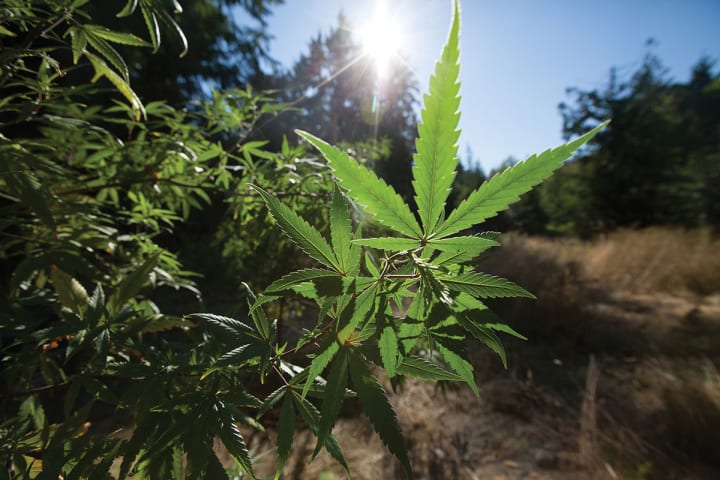
Photo via Marijuana
Were you worried about being discovered?
Once when I was there by myself. Martin and Robert had gone to town. I hadn't seen anybody for about six days. And these bicycle riders came riding up, because you could get in there pretty easy. I was sitting there naked, smoking this joint, and about four of them came over the hill. Couldn't believe it, you know, because they didn't make any noise. They came right up to it but couldn't see it. They were nice. They asked if they could camp there. I said, “No. This is private property and you shouldn't be around here—this is fenced.” But I wondered what they thought about this weird person out there without any clothes on, smoking a J.
How'd the idea to harvest a marijuana field come about in the first place?
Here's what the original idea was. One acre is 1,000 plants. 1,000 plants produce 1,000 pounds. 1,000 pounds at $1,000 a pound is $1,000,000.
Well, first of all, 1,000 plants don't produce 1,000 pounds when you harvest a marijuana field. Half of the plants, right up front, are females and half are males. So half are no good at all. The male plants are good smoke, but you can't sell them. Of all the plants, none of them made a pound. The biggest one made 451 grams. Most plants only make about two or three ounces. It's a lot of stalk.
We got $60,000 apiece. Paid off all my bills. It was nice to pay all your fucking bills.
We always knew it would be pretty good, but we didn't know how good. And then we harvested it. Picked it very carefully. And the people who smoked it couldn't believe it. It was very stony. And fantastic.
About the Creator
Potent Staff
A serious group of marijuana connoisseurs always giving back to the community. Peace.




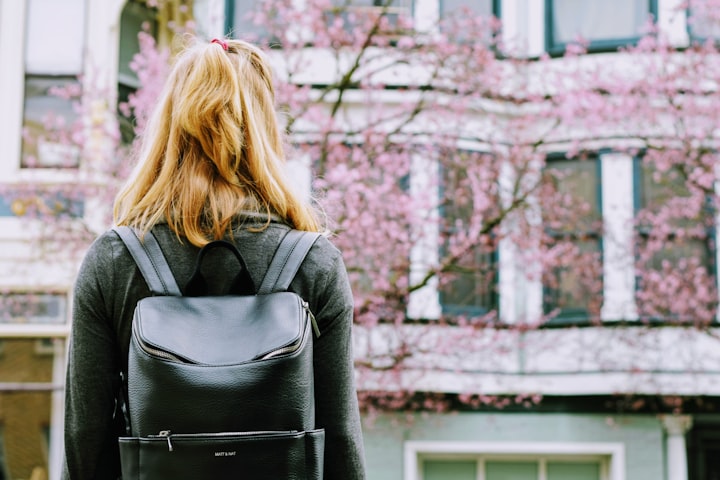
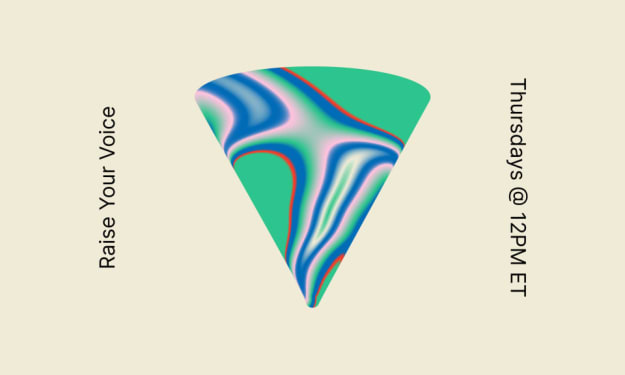
Comments
There are no comments for this story
Be the first to respond and start the conversation.